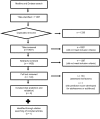Predicting childhood overweight and obesity using maternal and early life risk factors: a systematic review
- PMID: 29266702
- PMCID: PMC5805129
- DOI: 10.1111/obr.12640
Predicting childhood overweight and obesity using maternal and early life risk factors: a systematic review
Abstract
Background: Childhood obesity is a serious public health challenge, and identification of high-risk populations with early intervention to prevent its development is a priority. We aimed to systematically review prediction models for childhood overweight/obesity and critically assess the methodology of their development, validation and reporting.
Methods: Medline and Embase were searched systematically for studies describing the development and/or validation of a prediction model/score for overweight and obesity between 1 to 13 years of age. Data were extracted using the Cochrane CHARMS checklist for Prognosis Methods.
Results: Ten studies were identified that developed (one), developed and validated (seven) or externally validated an existing (two) prediction model. Six out of eight models were developed using automated variable selection methods. Two studies used multiple imputation to handle missing data. From all studies, 30,475 participants were included. Of 25 predictors, only seven were included in more than one model with maternal body mass index, birthweight and gender the most common.
Conclusion: Several prediction models exist, but most have not been externally validated or compared with existing models to improve predictive performance. Methodological limitations in model development and validation combined with non-standard reporting restrict the implementation of existing models for the prevention of childhood obesity.
Keywords: Childhood obesity; maternal factors; overweight; prediction models.
© 2017 The Authors. Obesity Reviews published by John Wiley & Sons Ltd on behalf of World Obesity Federation.
References
-
- World Health Organization . Global Strategy on Diet, Physical Activity and Health http://www.who.int/dietphysicalactivity/childhood/en/ (accessed 21/10/2016).
-
- Health and Social Care Information . Statistics on obesity, physical activity and diet England 2016, 2016.
-
- World Health Organization . Population‐Based Approaches to Childhood Obesity Prevention. World Health Organization: Geneva, Switzerland, 2012.
-
- HM Government . Childhood Obesity: A Plan for Action. Department of Health in London: UK, 2016.
-
- Galjaard S, Devlieger R, Van Assche FA. Fetal growth and developmental programming. J Perinat Med 2013; 41: 101–105. - PubMed
Publication types
MeSH terms
Grants and funding
LinkOut - more resources
Full Text Sources
Other Literature Sources
Medical


